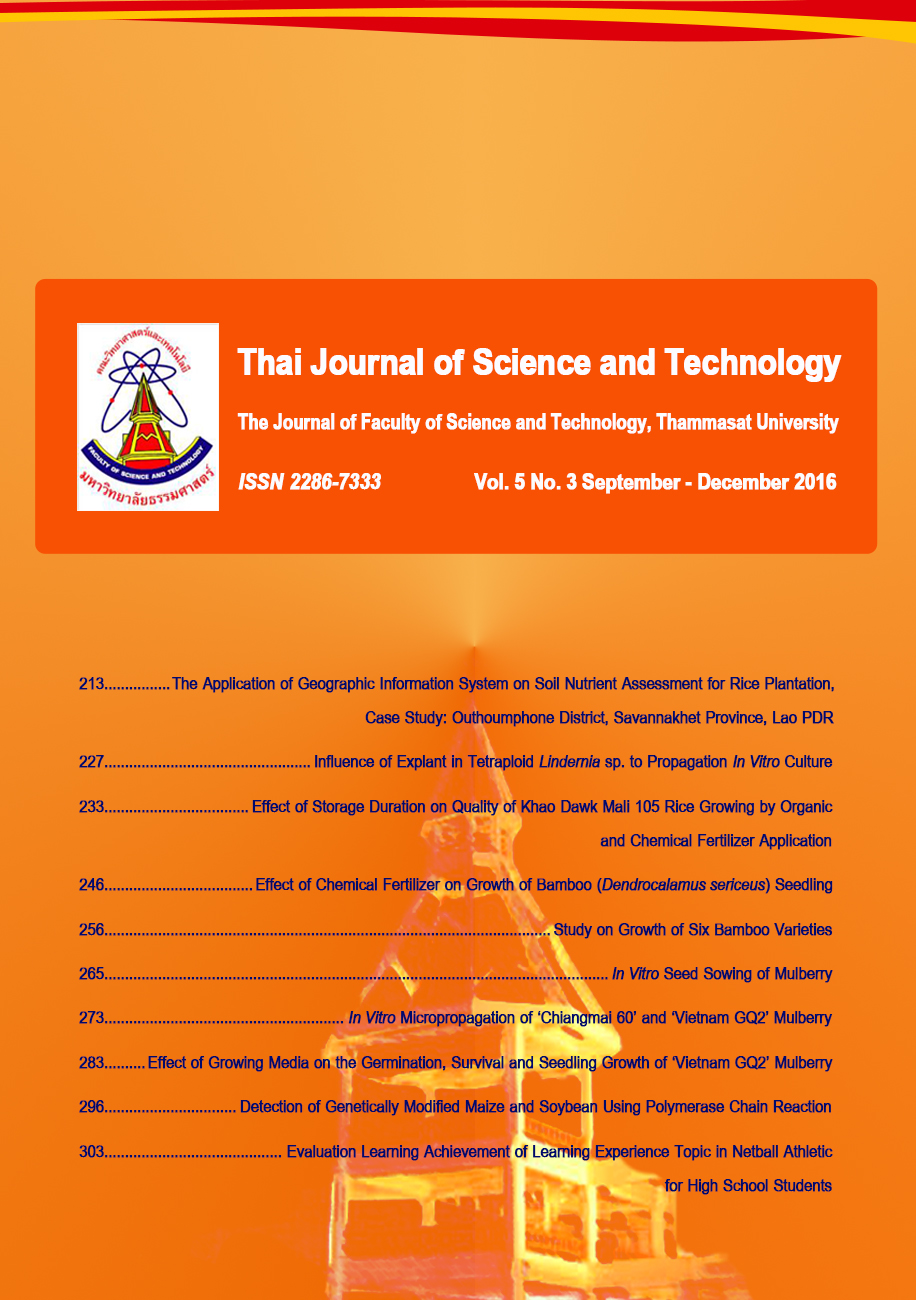ผลของปุ๋ยเคมีที่มีต่อการเจริญเติบโตของไผ่ซางหม่นที่เกิดจากเมล็ด
Main Article Content
Abstract
บทคัดย่อ
การศึกษาผลของปุ๋ยเคมีที่มีผลต่อการเจริญของไผ่ซางหม่น (Dendrocalamus sericeus) ที่เกิดจากเมล็ด ณ ภาควิชาเทคโนโลยีการเกษตร คณะวิทยาศาสตร์และเทคโนโลยี มหาวิทยาลัยธรรมศาสตร์ ศูนย์รังสิต จังหวัดปทุมธานี ระหว่างเดือนสิงหาคม พ.ศ. 2558 ถึงเดือนเมษายน พ.ศ. 2559 โดยเปรียบระหว่างไม่ใส่ปุ๋ยเคมี (ควบคุม) ปุ๋ยเคมีสูตร 46-0-0 ปุ๋ยเคมีสูตร 16-16-16 ปุ๋ยเคมีสูตร 25-7-7 ปุ๋ยเคมีสูตร 46-0-0 ร่วมกับ 16-16-16 ปุ๋ยเคมีสูตร 46-0-0 ร่วมกับ 25-7-7 และปุ๋ยเคมีสูตร 25-7-7 ร่วมกับ 16-16-16 อัตรา 5 กรัมต่อกระถาง หลังจากย้ายปลูก 4 เดือน เพิ่มเป็น 10 กรัมต่อกระถาง วางแผนการทดลองแบบสุ่มสมบูรณ์ (CRD) จำนวน 4 ซ้ำ และแบ่งการศึกษาออกเป็น 3 ระยะ คือ ที่อายุ 3, 6 และ 9 เดือน หลังย้ายปลูก ผลจากการศึกษาพบว่าการใส่ปุ๋ยเคมีสูตร 46-0-0 ส่งผลให้มีจำนวนหน่อเกิดใหม่สูงที่สุดในทุกระยะที่ศึกษา (6.37-11.00 หน่อต่อกอ) การใส่ปุ๋ยเคมีสูตร 46-0-0 และปุ๋ยเคมีสูตร 46-0-0 ร่วมกับ 16-16-16 ส่งผลให้ไผ่มีความสูงต้นที่ระยะ 3 เดือน หลังย้ายปลูก สูงที่สุดเท่ากับ 31.1 และ 31.2 เซนติเมตร ตามลำดับ อย่างไรก็ตาม การใส่ปุ๋ยเคมีสูตร 16-16-16 ส่งผลให้ไผ่มีความสูงต้นที่ระยะ 6 และ 9 เดือน หลังย้ายปลูก สูงที่สุด (151.6 และ 181.0 เซนติเมตร ตามลำดับ) การใส่ปุ๋ยเคมีส่งผลให้ใบไผ่ซางหม่นที่ระยะ 9 เดือน หลังย้ายปลูก มีความกว้างแตกต่างกันทางสถิติ โดยการใส่ปุ๋ยเคมีสูตร 46-0-0 ส่งผลให้ใบไผ่มีความกว้างมากที่สุด (3.02 เซนติเมตร) นอกจากนี้การใส่ปุ๋ยเคมีสูตร 46-0-0 กับ 25-7-7 ทำให้ใบไผ่ซางหม่นมีค่า SPAD สูงที่สุด เมื่อวัดสมบัติทางเคมีของดินหลังปลูกไผ่ 9 เดือน พบว่าการใส่ปุ๋ยเคมีทำให้ค่า pH ในดินแตกต่างกันทางสถิติ ขณะที่ค่า EC ไม่แตกต่างกันทางสถิติ โดยการใส่ปุ๋ยสูตร 46-0-0 ร่วมกับ 16-16-16 ส่งผลให้ค่า pH ของดินต่ำที่สุด
คำสำคัญ : ไผ่ซางหม่น; จำนวนหน่อใหม่; ปุ๋ยยูเรีย; การเจริญเติบโต
Abstract
Study on effect of different formula chemical fertilizer application on growth of bamboo (Dendrocalamus sericeus) seedling was conducted at the Department of Agricultural Technology, Science and Technology, Thammasat University, Pathum Thai province, between August, 2015 to April, 2016. The trial was arranged in a completely randomized design (CRD) with 4 replications. Seven treatments included no fertilizer application (control), 46-0-0 fertilizer application, 16-16-16 fertilizer application, 25-7-7 fertilizer application, 46-0-0 with 16-16-16 fertilizer application, 46-0-0 with 25-7-7 fertilizer application, and 25-7-7 with 16-16-16 fertilizer application. Fertilizer application rate of 5 grams per pot 4th months after transplantation increased to 10 grams per pot. The data at 3 periods including 3rd, 6th, and 9th months after transplanting. Results indicated that the application of 46-0-0 fertilizer gave the highest number of shoot emerging per pot (6.37 to 11.00 tillers per pot) in all phases of the study. The application of 46-0-0 and 46-0-0 with 16-16-16 resulted in the highest of bamboo height at 3rd month after transplantation (31.1 and 31.2 cm, respectively). The highest bamboo height at 6th and 9th month after transplantation were received the application of 16-16-16 fertilizer (151.6 and 181.0 cm, respectively). At the 9th month after transplantation, the application of 46-0-0 showed the widest of bamboo leaf (3.02 cm), however, application of 46-0-0 with 25-7-7 had the highest SPAD value in bamboo leaves. The different formula chemical fertilizer application was significant differed in soil chemical properties at 9th month after transplantation. The soil pH was significantly difference while the EC value was not difference. The 46-0-0 with 16-16-16 fertilizer application resulted in the lowest of soil pH level.
Keywords: Dendrocalamus sericeus; shoots emerging; urea fertilizer; growth of bamboo
Article Details
บทความที่ได้รับการตีพิมพ์เป็นลิขสิทธิ์ของคณะวิทยาศาสตร์และเทคโนโลยี มหาวิทยาลัยธรรมศาสตร์ ข้อความที่ปรากฏในแต่ละเรื่องของวารสารเล่มนี้เป็นเพียงความเห็นส่วนตัวของผู้เขียน ไม่มีความเกี่ยวข้องกับคณะวิทยาศาสตร์และเทคโนโลยี หรือคณาจารย์ท่านอื่นในมหาวิทยาลัยธรรมศาสตร์ ผู้เขียนต้องยืนยันว่าความรับผิดชอบต่อทุกข้อความที่นำเสนอไว้ในบทความของตน หากมีข้อผิดพลาดหรือความไม่ถูกต้องใด ๆ


